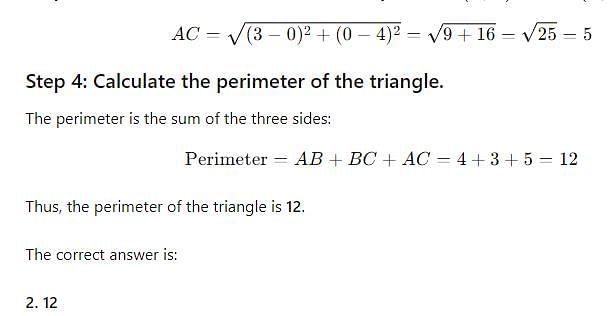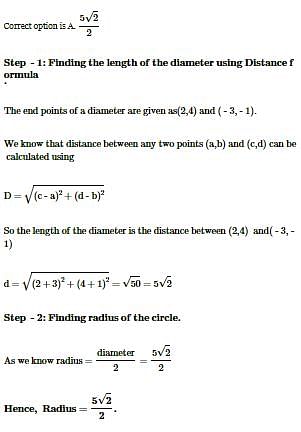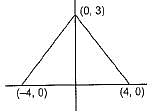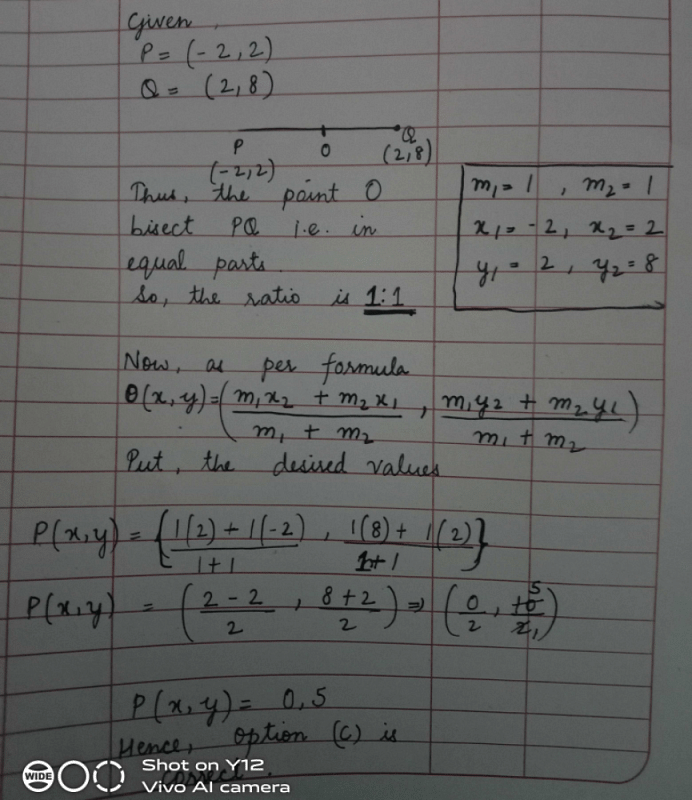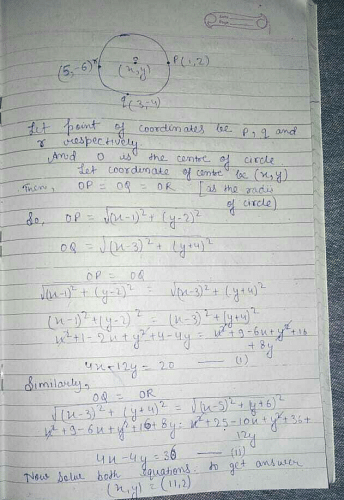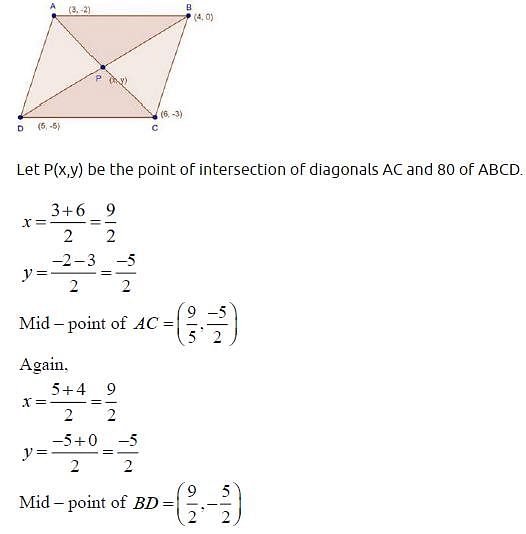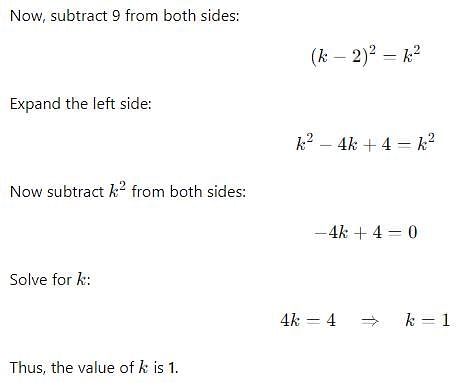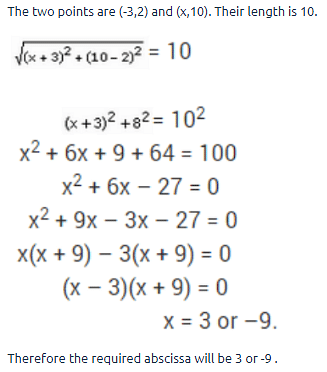All Exams >
SSS 1 >
Mathematics for SSS 1 >
All Questions
All questions of Polygons for SSS 1 Exam
| 1 Crore+ students have signed up on EduRev. Have you? Download the App |
If the co – ordinates of a point are (3, – 7), then its ordinate is- a)– 3
- b)– 7
- c)3
- d)7
Correct answer is option 'B'. Can you explain this answer?
If the co – ordinates of a point are (3, – 7), then its ordinate is
a)
– 3
b)
– 7
c)
3
d)
7
|
|
Amit Sharma answered |
Since y−coordinate is called ordinate.
Therefore, ordinate is −7.
Therefore, ordinate is −7.
Origin divides the join of points (1,1) and (2,2) externally in the ratio- a)1:2
- b)1:-2
- c)-1:-2
- d)-1:2
Correct answer is option 'A'. Can you explain this answer?
Origin divides the join of points (1,1) and (2,2) externally in the ratio
a)
1:2
b)
1:-2
c)
-1:-2
d)
-1:2
|
|
Kiran Mehta answered |
We have external section formula as


The points (k + 1, 1), (2k + 1, 3) and (2k + 2, 2k) are collinear if- a)k = - 1, 2
- b)

- c)k = 2, 1
- d)

Correct answer is option 'D'. Can you explain this answer?
The points (k + 1, 1), (2k + 1, 3) and (2k + 2, 2k) are collinear if
a)
k = - 1, 2
b)

c)
k = 2, 1
d)

|
|
Kiran Mehta answered |
∵ Points are collinear.
∴ (k + 1) (3 - 2k) + (2k, + 1) (2k - 1) + (2k + 2) (1 - 3) = 0
⇒ 3k+3 - 2k2 - 2k + 4k2 - 1 - 4k - 4 = 0 ⇒ 2k2 - 3k - 2 = 0
⇒ 2k2 - 4k + k - 2 = 0
⇒ 2k(k - 2) + 1(k - 2) = 0
⇒ (2k + 1) (k - 2) = 0

∴ (k + 1) (3 - 2k) + (2k, + 1) (2k - 1) + (2k + 2) (1 - 3) = 0
⇒ 3k+3 - 2k2 - 2k + 4k2 - 1 - 4k - 4 = 0 ⇒ 2k2 - 3k - 2 = 0
⇒ 2k2 - 4k + k - 2 = 0
⇒ 2k(k - 2) + 1(k - 2) = 0
⇒ (2k + 1) (k - 2) = 0

The distance of the point P (-6, 8) from the origin is- a)8
- b)2√7
- c)10
- d)6
Correct answer is option 'C'. Can you explain this answer?
The distance of the point P (-6, 8) from the origin is
a)
8
b)
2√7
c)
10
d)
6
|
|
Nirmal Kumar answered |
Let A(-6,8) and B(0,0),
by distance formula-->
distance between A and B=
√(x1-x2)²+(y1-y2)²,
=√(-6-0)²+(8-0)²,
=√(36)+(64),
=√100=10
by distance formula-->
distance between A and B=
√(x1-x2)²+(y1-y2)²,
=√(-6-0)²+(8-0)²,
=√(36)+(64),
=√100=10
The distance between the points A (0, 6) and B (0, -2) is- a)6
- b)8
- c)4
- d)2
Correct answer is option 'B'. Can you explain this answer?
The distance between the points A (0, 6) and B (0, -2) is
a)
6
b)
8
c)
4
d)
2
|
|
Amit Kumar answered |
Since both these points lie on a straight line i.e x axis, distance will be the difference between the respective y coordinates
(0,-2) & (0,6) => 6-(-2)) = 6+2 = 8
(0,-2) & (0,6) => 6-(-2)) = 6+2 = 8
If the distance between the points (p, – 5) and (2, 7) is 13 units, then the value of ‘p’ is- a)– 3, 7
- b)– 3, – 7
- c)3, – 7
- d)3, 7
Correct answer is option 'A'. Can you explain this answer?
If the distance between the points (p, – 5) and (2, 7) is 13 units, then the value of ‘p’ is
a)
– 3, 7
b)
– 3, – 7
c)
3, – 7
d)
3, 7
|
|
Arun Sharma answered |
Let point A be (p,−5)(p,−5) and point B (2, 7) and distance between A and B = 13 units

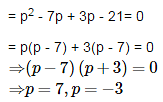
If the distance between the points (2, - 2) and (-1, x) is 5, one of the values of x is
- a)-2
- b)2
- c)-1
- d)1
Correct answer is option 'B'. Can you explain this answer?
If the distance between the points (2, - 2) and (-1, x) is 5, one of the values of x is
a)
-2
b)
2
c)
-1
d)
1
|
|
Naina Sharma answered |
Let us consider the points as
A = (2, -2)
B = (-1, x)
AB = 5 units
Using the distance formula
AB2 = (x₂ - x₁)2 + (y₂ - y₁)2
Substituting the values
52 = (-1 - 2)2 + (x + 2)2
25 = (-3)2 + (x + 2)2
Using the algebraic identity
(a + b)2 = a2 + b2 + 2ab
25 = 9 + x2 + 4 + 4x
By further calculation
25 = x2 + 4x + 13
x2 + 4x + 13 - 25 = 0
x2 + 4x - 12 = 0
By splitting the middle term
x2 + 6x - 2x - 12 = 0
Taking out the common terms
x(x + 6) - 2(x + 6) = 0
(x + 6)(x - 2) = 0
So we get
x + 6 = 0
x = -6
And
x - 2 = 0
x = 2
The distance between the points P (-6,7) and Q (-1,-5) is- a)15
- b)12
- c)13
- d)10
Correct answer is option 'C'. Can you explain this answer?
The distance between the points P (-6,7) and Q (-1,-5) is
a)
15
b)
12
c)
13
d)
10
|
|
sunaina Singh answered |
Distance between the points P(−6,7) and Q (−1,−5)=√(−1+6)2+(−5−7)2
=√25+144=
√169
=13
=√25+144=
√169
=13
The graph of the equation x = 3 is:- a)a point
- b)straight line parallel to y axis
- c)straight line passing through the origin
- d)straight line parallel to x axis
Correct answer is option 'B'. Can you explain this answer?
The graph of the equation x = 3 is:
a)
a point
b)
straight line parallel to y axis
c)
straight line passing through the origin
d)
straight line parallel to x axis
|
|
Naina Sharma answered |
x=3 is fixed. This means the value of x is constant. So y can vary but x has only one value. For example (3,0),(3,2),(3,5) etc. So the line drawn will be parallel to y axis as y can vary.
The ratio in which the line 2x+y-4 = 0 divides the line segment joining A(2,-2) and B(3,7) is- a)4:3
- b)1:9
- c)8:9
- d)2:9
Correct answer is option 'D'. Can you explain this answer?
The ratio in which the line 2x+y-4 = 0 divides the line segment joining A(2,-2) and B(3,7) is
a)
4:3
b)
1:9
c)
8:9
d)
2:9
|
|
Mohini iyer answered |
To find the ratio in which the line 2x + y - 4 = 0 divides the line segment AB, we can use the section formula.
Section Formula: The coordinates of the point P(x,y) that divides the line segment joining two points A(x₁,y₁) and B(x₂,y₂) in the ratio m:n are given by:
x = (mx₂ + nx₁) / (m + n)
y = (my₂ + ny₁) / (m + n)
Given that A(2,-2) and B(3,7), let's find the coordinates of the point where the line 2x + y - 4 = 0 intersects AB.
Step 1: Find the slope of the line 2x + y - 4 = 0
To find the slope, we can rewrite the equation in slope-intercept form:
y = -2x + 4
Comparing this with the standard form y = mx + c, we can see that the slope is -2.
Step 2: Find the equation of the line passing through A(2,-2) with slope -2
Using the point-slope form y - y₁ = m(x - x₁), we have:
y - (-2) = -2(x - 2)
y + 2 = -2x + 4
y = -2x + 2
Step 3: Find the coordinates of the point of intersection of the lines 2x + y - 4 = 0 and y = -2x + 2
To find the point of intersection, we can solve the simultaneous equations:
2x + y - 4 = 0 ...(1)
y = -2x + 2 ...(2)
Substituting equation (2) into equation (1), we have:
2x + (-2x + 2) - 4 = 0
0x - 2 = 2
-2 = 2
Since this is not a true statement, the lines are parallel and do not intersect. Therefore, the ratio in which the line 2x + y - 4 = 0 divides the line segment AB cannot be determined.
Hence, the correct answer is option 'D' (Cannot be determined).
Section Formula: The coordinates of the point P(x,y) that divides the line segment joining two points A(x₁,y₁) and B(x₂,y₂) in the ratio m:n are given by:
x = (mx₂ + nx₁) / (m + n)
y = (my₂ + ny₁) / (m + n)
Given that A(2,-2) and B(3,7), let's find the coordinates of the point where the line 2x + y - 4 = 0 intersects AB.
Step 1: Find the slope of the line 2x + y - 4 = 0
To find the slope, we can rewrite the equation in slope-intercept form:
y = -2x + 4
Comparing this with the standard form y = mx + c, we can see that the slope is -2.
Step 2: Find the equation of the line passing through A(2,-2) with slope -2
Using the point-slope form y - y₁ = m(x - x₁), we have:
y - (-2) = -2(x - 2)
y + 2 = -2x + 4
y = -2x + 2
Step 3: Find the coordinates of the point of intersection of the lines 2x + y - 4 = 0 and y = -2x + 2
To find the point of intersection, we can solve the simultaneous equations:
2x + y - 4 = 0 ...(1)
y = -2x + 2 ...(2)
Substituting equation (2) into equation (1), we have:
2x + (-2x + 2) - 4 = 0
0x - 2 = 2
-2 = 2
Since this is not a true statement, the lines are parallel and do not intersect. Therefore, the ratio in which the line 2x + y - 4 = 0 divides the line segment AB cannot be determined.
Hence, the correct answer is option 'D' (Cannot be determined).
The distance of a point from the y – axis is called- a)abscissa
- b)origin
- c)ordinate
- d)none of these
Correct answer is option 'A'. Can you explain this answer?
The distance of a point from the y – axis is called
a)
abscissa
b)
origin
c)
ordinate
d)
none of these
|
|
Ananya Das answered |
The distance of a point from the y – axis is called abscissa.
The point on x-axis which is equidistant from (5,9) and (-4,6) is- a)(3,0)
- b)(1,0)
- c)(2,0)
- d)(4,1)
Correct answer is option 'A'. Can you explain this answer?
The point on x-axis which is equidistant from (5,9) and (-4,6) is
a)
(3,0)
b)
(1,0)
c)
(2,0)
d)
(4,1)
|
|
Vikas Kumar answered |
for 2 points to be equidistant to 2 another the length of the line drawn to them should the first two should be equal to the next two.
let that point be (x,0) (y=0 as it leis on the x axis)
using distance formula-
root of ((x+4)2 +(0-6)2)=root of ((x-5)2 +(0-9)2)
squaring both sides and opening the brackets we get-
x2 + 8x + 16 + 36 = x2 - 10x + 25 +81
bring variables to one side and constants to another we get-
18x = 54
x = 54/18 = 3
therefore x = 3 and y =0 (since it leis in the x axis)
The ordinate of a point is twice its abscissa. If its distance from the point (4,3) is √10, then the coordinates of the point are- a)(1,2) or (3,6)
- b)(1,2) or (3,5)
- c)(2,1) or (3,6)
- d)(2,1) or (6,3)
Correct answer is option 'A'. Can you explain this answer?
The ordinate of a point is twice its abscissa. If its distance from the point (4,3) is √10, then the coordinates of the point are
a)
(1,2) or (3,6)
b)
(1,2) or (3,5)
c)
(2,1) or (3,6)
d)
(2,1) or (6,3)
|
|
Rahul Kapoor answered |
let the coordinate of that point be P(x,2x).
let the given point (4,3) be Q(4,3).
Then PQ=

The values of x and y, if the distance of the point (x,y) from (-3,0) as well as from (3,0) is 4 are- a)x = 1, y = 7
- b)x = 2, y = 7
- c)x = 0, y = – √7
- d)x = 0, y = ± √7
Correct answer is option 'D'. Can you explain this answer?
The values of x and y, if the distance of the point (x,y) from (-3,0) as well as from (3,0) is 4 are
a)
x = 1, y = 7
b)
x = 2, y = 7
c)
x = 0, y = – √7
d)
x = 0, y = ± √7
|
|
Nisha Choudhury answered |
Given, the distance of point P(x, y ) from A(– 3, 0) and B(3, 0) is 4 units.




The line segment joining (2, – 3) and (5, 6) is divided by x-axis in the ratio:- a)2 : 1
- b)3 : 1
- c)1 : 2
- d)1 : 3.
Correct answer is option 'A'. Can you explain this answer?
The line segment joining (2, – 3) and (5, 6) is divided by x-axis in the ratio:
a)
2 : 1
b)
3 : 1
c)
1 : 2
d)
1 : 3.
|
|
Krishna Iyer answered |
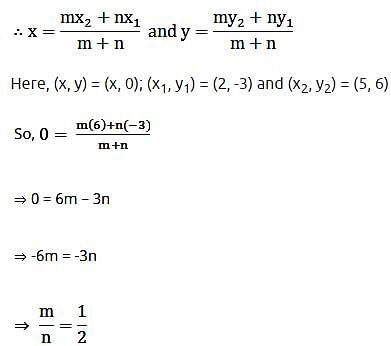
Hence, the ratio is 1:2 and the division is internal.
If P(1, 2), Q(4,6), R(5,7) and S(a, b) are the vertices of a parallelogram PQRS, then- a)a = 2, b = 4
- b)a = 3, b = 4
- c)a = 2, b = 3
- d)a = 3, b = 5
Correct answer is option 'C'. Can you explain this answer?
If P(1, 2), Q(4,6), R(5,7) and S(a, b) are the vertices of a parallelogram PQRS, then
a)
a = 2, b = 4
b)
a = 3, b = 4
c)
a = 2, b = 3
d)
a = 3, b = 5

|
Manasa Deshpande answered |
PQRS is a parallelogram if and only if the mid point of the diagonals PR is same as that of the mid point of Q, S. That is, if and only if

The points A (9, 0), B (9, 6), C (-9, 6) and D (-9, 0) are the vertices of a- a)square
- b)rectangle
- c)rhombus
- d)trapezium
Correct answer is option 'B'. Can you explain this answer?
The points A (9, 0), B (9, 6), C (-9, 6) and D (-9, 0) are the vertices of a
a)
square
b)
rectangle
c)
rhombus
d)
trapezium
|
|
Pratibha das answered |
Here is the solution to your question:
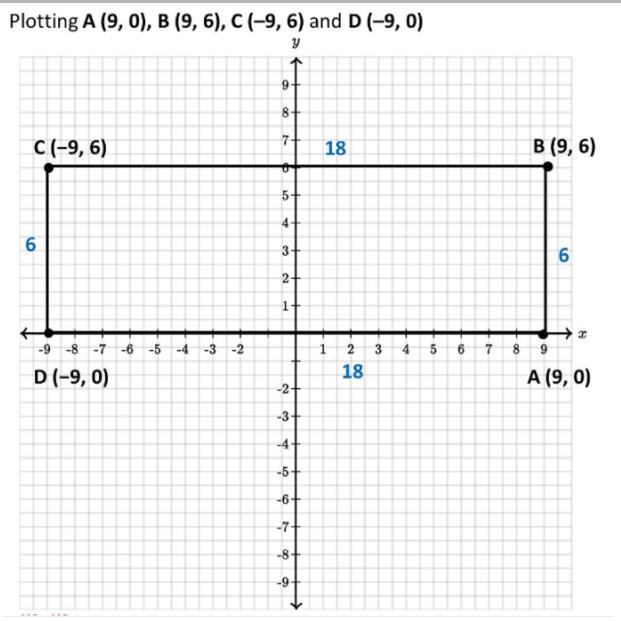
Since,
• Opposite sides are equal
• Sides are perpendicular to each other
Therefore, ABCD is a rectangle
So, the correct answer is B.
You can learn everything about Coordinate Geometry for Class 10 through the link:
Therefore, ABCD is a rectangle
So, the correct answer is B.
You can learn everything about Coordinate Geometry for Class 10 through the link:
The distance between the points A (0, 7) and B (0, -3) is- a)4 units
- b)10 units
- c)7 units
- d)3 units
Correct answer is option 'B'. Can you explain this answer?
The distance between the points A (0, 7) and B (0, -3) is
a)
4 units
b)
10 units
c)
7 units
d)
3 units
|
|
Amit Sharma answered |
Since both these points lie on a straight line i.e x axis, distance will be the difference between the respective y coordinates
(0,-3) (0,7)
7-(-3) = 7+3 = 10
The point (-1,-5) lies in the Quadrant- a)3rd
- b)1st
- c)2nd
- d)4th
Correct answer is option 'A'. Can you explain this answer?
The point (-1,-5) lies in the Quadrant
a)
3rd
b)
1st
c)
2nd
d)
4th
|
|
Rising Star answered |
Quadrant 1 = +,+
Quadrant 2= -,+
Quadrant 3= -,-
Quadrant 4 = +,-
Thus,the point (-1,-5 ) will lie in Quadrant 3 !!!
Quadrant 2= -,+
Quadrant 3= -,-
Quadrant 4 = +,-
Thus,the point (-1,-5 ) will lie in Quadrant 3 !!!
The distance of the point (– 3, 4) from the origin is- a)25 units
- b)1 unit
- c)7 units
- d)5 units
Correct answer is option 'D'. Can you explain this answer?
The distance of the point (– 3, 4) from the origin is
a)
25 units
b)
1 unit
c)
7 units
d)
5 units

|
Ayush Choudhary answered |
Let the given point be (x1, y1) = (-3, 4) and the orgin is (x2, y2) = (0, 0)
∴ Distance of the given point from the orgin =
∴ Distance of the given point from the orgin =

The perimeter of the triangle formed by the points A(0,0), B(1,0) and C(0,1) is- a)√2 + 1
- b)1 ± √2
- c)2 + √2
- d)3
Correct answer is option 'C'. Can you explain this answer?
The perimeter of the triangle formed by the points A(0,0), B(1,0) and C(0,1) is
a)
√2 + 1
b)
1 ± √2
c)
2 + √2
d)
3
|
|
Nisha Choudhury answered |
Consider A (0,0),B (1,0),C (0,1)
=>AB=root(X2-X1)^2+(Y2-Y1)^2
=>AB=root (1-0)^2+(1-0)^2
=>AB=1
similarly,
BC=root2
and
AC=1
Perimeter=AB+BC+AC
=1+root1+1
=2+root2
If the four points (0,-1), (6,7),(-2,3) and (8,3) are the vertices of a rectangle, then its area is- a)40 sq. units
- b)12 sq. units
- c)10 sq. units
- d)13 sq. units
Correct answer is option 'A'. Can you explain this answer?
If the four points (0,-1), (6,7),(-2,3) and (8,3) are the vertices of a rectangle, then its area is
a)
40 sq. units
b)
12 sq. units
c)
10 sq. units
d)
13 sq. units
|
|
Arun Sharma answered |
Let A(0-1), B(6,7), C(-2,3) and D(8,3) be the given points. Then
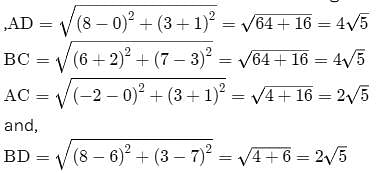

∴ AD = BC and AC = BD
So, ADBC is a parallelogram
Now 

Clearly, AB2 = AD2 + DB2 and CD2 = CB2 + BD2
Hence, ADBC is a rectangle.
Now
,Area of rectangle ADBC = AD × DB =(4√5 × 2√5)sq. units = 40sq. units
The distance between the points A(p sin 25∘, 0) and B(0, p sin 65∘) is- a)p units
- b)p2 units
- c)1 units
- d)0 units
Correct answer is option 'A'. Can you explain this answer?
The distance between the points A(p sin 25∘, 0) and B(0, p sin 65∘) is
a)
p units
b)
p2 units
c)
1 units
d)
0 units
|
|
Naina Sharma answered |
p units p2 units 1 units 0 units Distance between 


The point where the medians of a triangle meet is called the ________ of the triangle- a)centroid
- b)circumcentre
- c)orthocentre
- d)none of these
Correct answer is option 'A'. Can you explain this answer?
The point where the medians of a triangle meet is called the ________ of the triangle
a)
centroid
b)
circumcentre
c)
orthocentre
d)
none of these
|
|
Ananya Das answered |
The point where the medians of a triangle meet is called thecentroidof the triangle.
If (a, 0) , (0, b) and (x, y) are collinear, then- a)ay + bx = ab
- b)ax + by = 1
- c)ax – by = ab
- d)ay – bx = 1
Correct answer is option 'A'. Can you explain this answer?
If (a, 0) , (0, b) and (x, y) are collinear, then
a)
ay + bx = ab
b)
ax + by = 1
c)
ax – by = ab
d)
ay – bx = 1
|
|
Arun Sharma answered |
If given points are collinear, the triangle formed by these three points is 0.

The condition that the point (x,y) may lie on the line joining (3,4) and (-5,-6) is- a)-5x+4y+1=0
- b)-5x-4y+1=0
- c)5x+4y+1=0
- d)5x-4y+1=0
Correct answer is option 'D'. Can you explain this answer?
The condition that the point (x,y) may lie on the line joining (3,4) and (-5,-6) is
a)
-5x+4y+1=0
b)
-5x-4y+1=0
c)
5x+4y+1=0
d)
5x-4y+1=0
|
|
Nisha Choudhury answered |
Since the point P(x,y) lies on the line joining A(3,4) and B(-5,-6),
Therefore, points P, A and B are collinear points.
So, area of triangle PAB = 0
Therefore, we have:
10x-18-3y-5y+20=0
10x-8y+2=0
5x-4y+1=0 , which is the required condition.
The ratio in which the x-axis divides the segment joining A(3,6) and B(12,-3) is- a)1:2
- b)-2:1
- c)2:1
- d)-1:-1
Correct answer is option 'C'. Can you explain this answer?
The ratio in which the x-axis divides the segment joining A(3,6) and B(12,-3) is
a)
1:2
b)
-2:1
c)
2:1
d)
-1:-1
|
|
Manisha choudhary answered |
Given: A(3,6), B(12,-3)
To find: The ratio in which the x-axis divides the segment joining A and B
Solution:
Step 1: Plot the given points A and B on the graph.
Step 2: Draw a line parallel to the y-axis passing through A and B.
Step 3: Let O be the point where the line intersects the x-axis.
Step 4: Find the distance OA and OB.
OA = 3 (since the point A lies on the x-axis)
OB = distance between points B and O
Using distance formula, OB = √[(12-0)² + (-3-0)²] = √(144+9) = √153
Step 5: Find the ratio in which point O divides the line segment AB.
Let the ratio be k:1
By section formula, we have:
x-coordinate of O = (k * x-coordinate of B + 1 * x-coordinate of A)/(k+1)
Since the point O lies on the x-axis, its y-coordinate is 0.
Therefore, we have:
(k * 12 + 3)/(k+1) = 0
k * 12 + 3 = 0
k = -3/12 = -1/4
The ratio in which the x-axis divides the segment joining A and B is 1: (-1/4) = 4: (-1)
Since the ratio is negative, we can write it as -4:1.
Therefore, the correct answer is option C) 2:1.
To find: The ratio in which the x-axis divides the segment joining A and B
Solution:
Step 1: Plot the given points A and B on the graph.
Step 2: Draw a line parallel to the y-axis passing through A and B.
Step 3: Let O be the point where the line intersects the x-axis.
Step 4: Find the distance OA and OB.
OA = 3 (since the point A lies on the x-axis)
OB = distance between points B and O
Using distance formula, OB = √[(12-0)² + (-3-0)²] = √(144+9) = √153
Step 5: Find the ratio in which point O divides the line segment AB.
Let the ratio be k:1
By section formula, we have:
x-coordinate of O = (k * x-coordinate of B + 1 * x-coordinate of A)/(k+1)
Since the point O lies on the x-axis, its y-coordinate is 0.
Therefore, we have:
(k * 12 + 3)/(k+1) = 0
k * 12 + 3 = 0
k = -3/12 = -1/4
The ratio in which the x-axis divides the segment joining A and B is 1: (-1/4) = 4: (-1)
Since the ratio is negative, we can write it as -4:1.
Therefore, the correct answer is option C) 2:1.
Practice Test/Quiz or MCQ (Multiple Choice Questions) with Solutions of Chapter "Coordinate Geometry" are available for CBSE Class 10 Mathematics (Maths) and have been compiled as per the syllabus of CBSE Class 10 Mathematics (Maths) Q. The distance between the points (a, b) and (– a, – b) is :- a)a2+b2
- b)

- c)0
- d)

Correct answer is option 'D'. Can you explain this answer?
Practice Test/Quiz or MCQ (Multiple Choice Questions) with Solutions of Chapter "Coordinate Geometry" are available for CBSE Class 10 Mathematics (Maths) and have been compiled as per the syllabus of CBSE Class 10 Mathematics (Maths)
Q. The distance between the points (a, b) and (– a, – b) is :
a)
a2+b2
b)
c)
0
d)
|
|
Ananya Das answered |
We have distance formula as d = 
Where x1=a,y1=b,x2=-a,y2=-b


Where x1=a,y1=b,x2=-a,y2=-b

If A (1,2) , B (4,y), c (x,6) and D (3,5) are the vertices of a parallelogram taken in order then the values of x and y are:- a)6 and 3
- b)5 and 2
- c)2 and 3
- d)6 and 5
Correct answer is option 'A'. Can you explain this answer?
If A (1,2) , B (4,y), c (x,6) and D (3,5) are the vertices of a parallelogram taken in order then the values of x and y are:
a)
6 and 3
b)
5 and 2
c)
2 and 3
d)
6 and 5
|
|
Sushant Choudhary answered |
**Given:**
- The vertices of a parallelogram are A (1,2) , B (4,y), c (x,6) and D (3,5) taken in order.
**To find:**
- The values of x and y.
**Solution:**
- Let's first draw the parallelogram and label its sides.
- We know that the opposite sides of a parallelogram are equal in length and parallel to each other.
- Therefore, we can use the distance formula to find the length of the sides and equate them.
- AB = CD and BC = AD.
- AB = sqrt((4-1)^2 + (y-2)^2)
- CD = sqrt((x-3)^2 + (5-6)^2)
- Equating AB and CD, we get:
- sqrt((4-1)^2 + (y-2)^2) = sqrt((x-3)^2 + (5-6)^2)
- (4-1)^2 + (y-2)^2 = (x-3)^2 + (5-6)^2
- (y-2)^2 - (x-3)^2 = 2
- (y-2+x-3)(y-2-x+3) = 2
- (y+x-5)(-y-x+5) = 2
- Similarly, we can find the length of BC and AD and equate them.
- BC = sqrt((x-4)^2 + (6-y)^2)
- AD = sqrt((3-1)^2 + (5-2)^2)
- Equating BC and AD, we get:
- sqrt((x-4)^2 + (6-y)^2) = sqrt(2^2 + 3^2)
- (x-4)^2 + (6-y)^2 = 13
- Now we have two equations with two variables (x and y).
- Solving them simultaneously, we get x = 6 and y = 3.
**Answer:**
- The values of x and y are 6 and 3 respectively.
- Therefore, option A is correct.
- The vertices of a parallelogram are A (1,2) , B (4,y), c (x,6) and D (3,5) taken in order.
**To find:**
- The values of x and y.
**Solution:**
- Let's first draw the parallelogram and label its sides.
- We know that the opposite sides of a parallelogram are equal in length and parallel to each other.
- Therefore, we can use the distance formula to find the length of the sides and equate them.
- AB = CD and BC = AD.
- AB = sqrt((4-1)^2 + (y-2)^2)
- CD = sqrt((x-3)^2 + (5-6)^2)
- Equating AB and CD, we get:
- sqrt((4-1)^2 + (y-2)^2) = sqrt((x-3)^2 + (5-6)^2)
- (4-1)^2 + (y-2)^2 = (x-3)^2 + (5-6)^2
- (y-2)^2 - (x-3)^2 = 2
- (y-2+x-3)(y-2-x+3) = 2
- (y+x-5)(-y-x+5) = 2
- Similarly, we can find the length of BC and AD and equate them.
- BC = sqrt((x-4)^2 + (6-y)^2)
- AD = sqrt((3-1)^2 + (5-2)^2)
- Equating BC and AD, we get:
- sqrt((x-4)^2 + (6-y)^2) = sqrt(2^2 + 3^2)
- (x-4)^2 + (6-y)^2 = 13
- Now we have two equations with two variables (x and y).
- Solving them simultaneously, we get x = 6 and y = 3.
**Answer:**
- The values of x and y are 6 and 3 respectively.
- Therefore, option A is correct.
The values of ‘y’ for which the distance between the points (2, – 3) and (10, y) is 10 units is- a)– 3, – 9
- b)3, 9
- c)– 3, 9
- d)3, – 9
Correct answer is option 'D'. Can you explain this answer?
The values of ‘y’ for which the distance between the points (2, – 3) and (10, y) is 10 units is
a)
– 3, – 9
b)
3, 9
c)
– 3, 9
d)
3, – 9
|
|
Krishna Iyer answered |
Let one point be A (2,−3) and 2nd point is B (10,y) and
distance between point A and point B = AB = 10 units
Three consecutive vertices of a parallelogram ABCD are A(1, 2), B(1, 0) and C(4, 0). The co – ordinates of the fourth vertex D are- a)(– 4, – 2)
- b)(4, – 2)
- c)(– 4, 2)
- d)(4, 2)
Correct answer is option 'D'. Can you explain this answer?
Three consecutive vertices of a parallelogram ABCD are A(1, 2), B(1, 0) and C(4, 0). The co – ordinates of the fourth vertex D are
a)
(– 4, – 2)
b)
(4, – 2)
c)
(– 4, 2)
d)
(4, 2)
|
|
Radha Iyer answered |
Let coordinates of D be (x, y).
Since diagonals of a parallelogram bisect each other.
Since diagonals of a parallelogram bisect each other.
Therefore, coordinates of O will be 





Therefore, the required coordinates are (4, 2).

The mid-point of the line segment joining the points A (-2, 8) and B (-6, -4) is- a)(-4, -6)
- b)(2, 6)
- c)(-4, 2)
- d)(4, 2)
Correct answer is option 'C'. Can you explain this answer?
The mid-point of the line segment joining the points A (-2, 8) and B (-6, -4) is
a)
(-4, -6)
b)
(2, 6)
c)
(-4, 2)
d)
(4, 2)
|
|
Sarika kumar answered |
Given: Points A(-2,8) and B(-6,-4)
To find: Mid-point of the line segment joining A and B
Formula for Mid-point:
Mid-point = [(x1+x2)/2, (y1+y2)/2]
where (x1,y1) and (x2,y2) are the coordinates of the two points.
Calculation:
Using the formula for Mid-point, we get:
Mid-point = [(-2-6)/2, (8-4)/2]
Mid-point = [-4, 2]
Therefore, the mid-point of the line segment joining A and B is (-4,2).
Hence, option C is the correct answer.
To find: Mid-point of the line segment joining A and B
Formula for Mid-point:
Mid-point = [(x1+x2)/2, (y1+y2)/2]
where (x1,y1) and (x2,y2) are the coordinates of the two points.
Calculation:
Using the formula for Mid-point, we get:
Mid-point = [(-2-6)/2, (8-4)/2]
Mid-point = [-4, 2]
Therefore, the mid-point of the line segment joining A and B is (-4,2).
Hence, option C is the correct answer.
Chapter doubts & questions for Polygons - Mathematics for SSS 1 2024 is part of SSS 1 exam preparation. The chapters have been prepared according to the SSS 1 exam syllabus. The Chapter doubts & questions, notes, tests & MCQs are made for SSS 1 2024 Exam. Find important definitions, questions, notes, meanings, examples, exercises, MCQs and online tests here.
Chapter doubts & questions of Polygons - Mathematics for SSS 1 in English & Hindi are available as part of SSS 1 exam.
Download more important topics, notes, lectures and mock test series for SSS 1 Exam by signing up for free.
Mathematics for SSS 1
59 videos|244 docs|72 tests
|
Signup to see your scores go up within 7 days!
Study with 1000+ FREE Docs, Videos & Tests
10M+ students study on EduRev
|
Free Exam Preparation
at your Fingertips!
Access Free Study Material - Test Series, Structured Courses, Free Videos & Study Notes and Prepare for Your Exam With Ease

 Join the 10M+ students on EduRev
Join the 10M+ students on EduRev
|

|
Forgot Password
OR
Signup to see your scores
go up within 7 days!
Access 1000+ FREE Docs, Videos and Tests
Takes less than 10 seconds to signup



